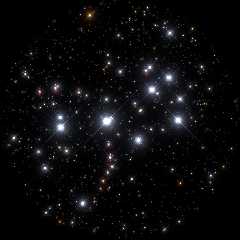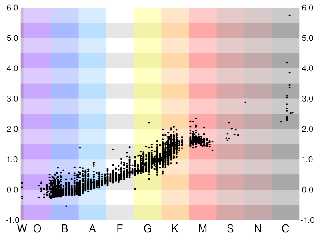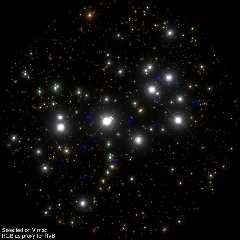 |
 |
|
 |
|
 |
|  |
|  |
|
 |
|
 |
|  |
|  |
|
 |
Thanks, Christian, for bringing NOMAD to my attention.
Now, for a related, but non-POV question for you resident astronomers and color
experts. You'll notice a lot of ruby red stars in the attached image. I have
found only one (1) formula to convert color filter data to temperature, from
Cameron Reed of Alma College. It is an empirical curve-fit, and it has its
deficiencies. At a B-V below around -0.373, the formula has no real roots. On
the cooler side, a B-V of 5.575, well within the range of the measured stars,
returns the freezing point of water! The ruby red stars are probably the best
way that CIE.inc has of telling me, "You're in the mid-to-far infrared, silly!"
Does anyone know of a more accurate way to reconstitute color from color filter
data? Perhaps it's worth my sampling a few stars of known temperature and
creating my own curve.
Post a reply to this message
Attachments:
Download 'nomad_test-m45.png' (300 KB)
Preview of image 'nomad_test-m45.png'

|
 |
|  |
|  |
|
 |
|
 |
|  |
|  |
|
 |
> On the cooler side, a B-V of 5.575, well within the range of the
> measured stars
That sounds fishy to me. The coolest stars should have B-V
of about 2.0 or so. Note that not all catalogs have all colors
and V = 30 seems to indicate there is no V data available.
Post a reply to this message
|
 |
|  |
|  |
|
 |
|
 |
|  |
|  |
|
 |
Christian Froeschlin <chr### [at] chrfr de> wrote:
> > On the cooler side, a B-V of 5.575, well within the range of the
> > measured stars
>
> That sounds fishy to me. The coolest stars should have B-V
> of about 2.0 or so. Note that not all catalogs have all colors
> and V = 30 seems to indicate there is no V data available.
I limited the search to stars with V <= 15, and double-checked that no stars of
V = 30 were returned. If the B value was 30, then I skipped the color
calculation and used plain white. Even so, the highest B-V was 10.450.
The coolest star in the BSC4 has a B-V of 5.74, and is type C6IIe. (A carbon
star would screw up the black body correlation, wouldn't it?) I don't know if
all the high B-V stars are carbon stars. Also, I don't know what a carbon star
looks like. de> wrote:
> > On the cooler side, a B-V of 5.575, well within the range of the
> > measured stars
>
> That sounds fishy to me. The coolest stars should have B-V
> of about 2.0 or so. Note that not all catalogs have all colors
> and V = 30 seems to indicate there is no V data available.
I limited the search to stars with V <= 15, and double-checked that no stars of
V = 30 were returned. If the B value was 30, then I skipped the color
calculation and used plain white. Even so, the highest B-V was 10.450.
The coolest star in the BSC4 has a B-V of 5.74, and is type C6IIe. (A carbon
star would screw up the black body correlation, wouldn't it?) I don't know if
all the high B-V stars are carbon stars. Also, I don't know what a carbon star
looks like.
Post a reply to this message
|
 |
|  |
|  |
|
 |
|
 |
|  |
|  |
|
 |
On 18-12-2011 6:31, Cousin Ricky wrote:
Also, I don't know what a carbon star
> looks like.
A huge diamond? ;-)
Thomas
Post a reply to this message
|
 |
|  |
|  |
|
 |
|
 |
|  |
|  |
|
 |
Cousin Ricky wrote:
> The coolest star in the BSC4 has a B-V of 5.74, and is type C6IIe. (A carbon
> star would screw up the black body correlation, wouldn't it?) I don't know if
> all the high B-V stars are carbon stars. Also, I don't know what a carbon star
> looks like.
Ah, you are of course correct. For more exotic spectral classes,
where the color of the star is not dominated by a blackbody spectrum,
you can easily get B-V outside the common "temperature" range. In the
case of carbon stars the abundant carbon in the atmosphere of the star
absorbs much of the blue light that would otherwise be emitted.
To really be certain about this you need to have a spectrum of
the star so you know the spectral class. That information is much
less readily available. About 300K+ stars with known spectrum are
in http://en.wikipedia.org/wiki/Henry_Draper_Catalogue. On the
other hand, if you see a star with B-V > 2.0 it's probably a
good bet that you shouldn't interpret this as temperature.
Now, all of this may be a bit overkill for your purposes, since
you are not trying to understand the stellar physics but actually
want the color for rendering. The values of B, V and R already
represent direct measurement of emission strength for various
optical wavelength ranges. So you might be better of trying to
construct an RGB color from that directly (very crude first
approximation would be to simply convert the magnitudes into
some linear brightness scale and then use <R',V',B'> as RGB).
This is related to human color perception so astrophysical
formulae will not help you much here. Astrophotographers need
to consider similar issues for color balance (see, for example,
B-V calibration at http://astrophoton.com/tips.htm). But they
are taking images with human perception in mind so they don't
have to convert from catalog B-V, of course. Planetarium
software probably does something like this.
Post a reply to this message
|
 |
|  |
|  |
|
 |
|
 |
|  |
|  |
|
 |
Christian Froeschlin <chr### [at] chrfr de> wrote:
> Cousin Ricky wrote:
>
> > The coolest star in the BSC4 has a B-V of 5.74, and is type C6IIe. (A carbon
> > star would screw up the black body correlation, wouldn't it?) I don't know if
> > all the high B-V stars are carbon stars. Also, I don't know what a carbon star
> > looks like.
>
> Ah, you are of course correct. For more exotic spectral classes,
> where the color of the star is not dominated by a blackbody spectrum,
> you can easily get B-V outside the common "temperature" range. In the
> case of carbon stars the abundant carbon in the atmosphere of the star
> absorbs much of the blue light that would otherwise be emitted.
>
> To really be certain about this you need to have a spectrum of
> the star so you know the spectral class. That information is much
> less readily available. About 300K+ stars with known spectrum are
> in http://en.wikipedia.org/wiki/Henry_Draper_Catalogue. On the
> other hand, if you see a star with B-V > 2.0 it's probably a
> good bet that you shouldn't interpret this as temperature.
Attached is a plot of B-V color index against spectral class, using BSC4 data.
I omitted objects with no color index and stars whose spectral data I could not
make sense of. de> wrote:
> Cousin Ricky wrote:
>
> > The coolest star in the BSC4 has a B-V of 5.74, and is type C6IIe. (A carbon
> > star would screw up the black body correlation, wouldn't it?) I don't know if
> > all the high B-V stars are carbon stars. Also, I don't know what a carbon star
> > looks like.
>
> Ah, you are of course correct. For more exotic spectral classes,
> where the color of the star is not dominated by a blackbody spectrum,
> you can easily get B-V outside the common "temperature" range. In the
> case of carbon stars the abundant carbon in the atmosphere of the star
> absorbs much of the blue light that would otherwise be emitted.
>
> To really be certain about this you need to have a spectrum of
> the star so you know the spectral class. That information is much
> less readily available. About 300K+ stars with known spectrum are
> in http://en.wikipedia.org/wiki/Henry_Draper_Catalogue. On the
> other hand, if you see a star with B-V > 2.0 it's probably a
> good bet that you shouldn't interpret this as temperature.
Attached is a plot of B-V color index against spectral class, using BSC4 data.
I omitted objects with no color index and stars whose spectral data I could not
make sense of.
Post a reply to this message
Attachments:
Download 'bsc4_colors.png' (60 KB)
Preview of image 'bsc4_colors.png'

|
 |
|  |
|  |
|
 |
|
 |
|  |
|  |
|
 |
Christian Froeschlin <chr### [at] chrfr de> wrote:
> (very crude first
> approximation would be to simply convert the magnitudes into
> some linear brightness scale and then use <R',V',B'> as RGB).
Very crude. :-P de> wrote:
> (very crude first
> approximation would be to simply convert the magnitudes into
> some linear brightness scale and then use <R',V',B'> as RGB).
Very crude. :-P
Post a reply to this message
Attachments:
Download 'nomad_test-m453.png' (289 KB)
Preview of image 'nomad_test-m453.png'

|
 |
|  |
|  |
|
 |
|
 |
|  |
|
 |




![]()